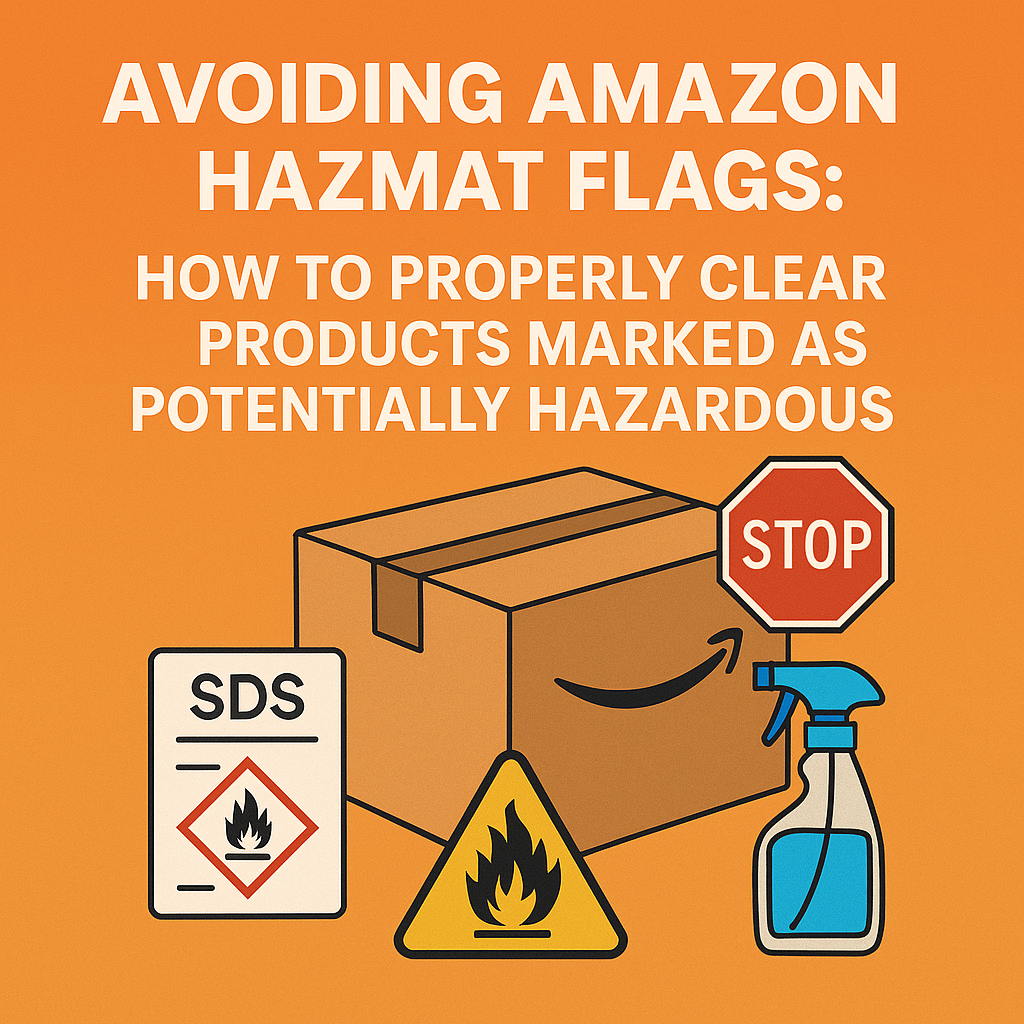Amazon Hazmat Flags: How to Properly Clear Products Marked as Potentially Hazardous
Getting your product flagged as a “potentially hazardous good” on Amazon is one of the most common — and preventable — obstacles FBA sellers encounter. Whether you're selling essential oils, electronics, cleaning supplies, or cosmetic kits, understanding how Amazon evaluates product safety and how to submit proper documentation can mean the difference between a product stuck in hazmat limbo and one flying off warehouse shelves.
In this guide, we’ll break down:
- Why Amazon flags certain ASINs as hazmat
- How to correctly submit SDS or exemption documentation
- Special handling for kits and multipacks
- Common errors that cause rejections
- Links to all relevant Seller Central tools
🚨 Why Amazon Flags Products as Potentially Hazardous
Amazon uses keyword scanning and product attribute algorithms to flag listings for hazmat review. Even if your product is non-hazardous by every standard, the language in your listing or packaging can trigger an investigation.
Top Hazmat Flag Triggers:
- Battery-related terms: lithium, Li-ion, rechargeable, USB-powered
- Liquid or aerosol descriptors: spray, mist, oil, gel, serum, cleaning fluid
- Pressurized packaging: aerosol cans, CO₂ cartridges, pump dispensers
- Chemical names: even naturally derived chemicals in cosmetics can trigger a flag
- Bundled items or kits: combinations of otherwise benign items (like candles + oil) often confuse Amazon’s system
These triggers don’t always mean your product is actually hazardous — but they do require you to prove that it isn’t.
🧾 Step-by-Step: How to Clear a Hazmat Flag on Amazon
Once your product is flagged, you’ll need to submit one of the following via Amazon’s compliance portal:
- A valid Safety Data Sheet (SDS) — required for products that contain any substance that could be hazardous
- A Dangerous Goods Exemption Sheet — used for products that do not contain hazardous materials
Here’s how to handle each scenario.
🔧 Step 1: Access the FBA Dangerous Goods Compliance Portal
Start here to upload documentation and view flagged ASINs:
👉 Dangerous Goods Documentation Portal
This portal allows you to:
- View ASINs under hazmat review
- Upload SDS or exemption sheets
- Track approval/rejection status
📄 Step 2: Determine Which Document to Submit
Submit a Safety Data Sheet (SDS) if:
- Your product contains batteries, liquids, gels, sprays, magnets, or chemicals
- You are unsure whether a component is considered hazardous
Submit an Exemption Sheet if:
- The product contains no regulated substances
- You are bundling non-hazardous items like fabrics, books, or dry cosmetics
📝 Exemption form template (US FBA):
👉 Download Exemption Sheet
✅ Step 3: Ensure Documentation Is Complete and Accurate
SDS Requirements:
- Must be dated within the last 12 months
- Includes the exact product name and manufacturer details
- Clearly lists all physical and chemical properties (Section 9)
- Declares classification and transport information (Section 14)
- If not regulated, Section 14 should explicitly state “Not regulated for transport”
- Must match your product listing details (dimensions, composition)
Exemption Sheet Checklist:
- All fields filled in accurately
- Weight and dimensions match your Amazon listing
- Batteries: explicitly select “No” unless included
- All components of a kit must be listed
- If bundling products, list each item and ensure none contain regulated materials
🧩 Special Considerations for Kits, Multipacks, and Bundles
Amazon evaluates kits and multipacks as a single unit — this is a major stumbling block for many sellers.
⚠️ Common Kit Mistakes:
- Submitting an SDS for only one item in a bundle (e.g., diffuser but not the included oil)
- Failing to list each item on the exemption sheet
- Packaging not labeled to reflect each included component
✅ Correct Kit Handling:
- Submit a combined SDS for the entire kit or
- Submit a comprehensive exemption sheet listing each item (e.g., facial sponge, jade roller, serum — all declared as non-hazardous)
🛑 Common Hazmat Documentation Rejection Reasons
Outdated SDS- Must be issued within the last 12 months
Missing Section 14- SDS must clearly state transportation classification
Dimensions mismatch- If declared dimensions don’t match Amazon listing, rejection is likely
Incorrect battery declaration- Leaving the battery field blank or marked incorrectly
Submitting a label instead of an SDS- Product packaging ≠ regulatory document
Even one inconsistency can trigger a rejection and delay your listing for weeks.
📬 What Happens After Submission?
- Standard review time: 4–7 business days (can be longer during peak seasons)
- If approved: Listing becomes active or hazmat flag is lifted
- If rejected: You’ll receive a reason for rejection and need to revise/resubmit
Track progress in the portal:
👉 Dangerous Goods Status Tracker
🧠 Pro Tips for Streamlining the Hazmat Review Process
- Don’t wait for a flag — proactively submit SDS or exemption sheets for at-risk ASINs
- Include product photos with your documentation to clarify packaging (especially for bundles)
- Match your listing copy to your compliance documents — avoid "charged," "chemical-free," or "powerful formula" phrasing if unnecessary
- Create a compliance folder for all ASINs to keep SDS and exemptions organized and accessible
📚 Helpful Links and Resources
Final Thoughts
Navigating Amazon's dangerous goods system isn't just about compliance — it's about protecting your margins, maintaining inventory flow, and ensuring uninterrupted sales. By proactively managing documentation and avoiding common mistakes, sellers can save weeks of downtime and thousands in lost revenue.
Need help reviewing your SDS or exemption documents before you submit? Contact our compliance team — we’ve helped hundreds of sellers clear flags and get back to selling, fast.
